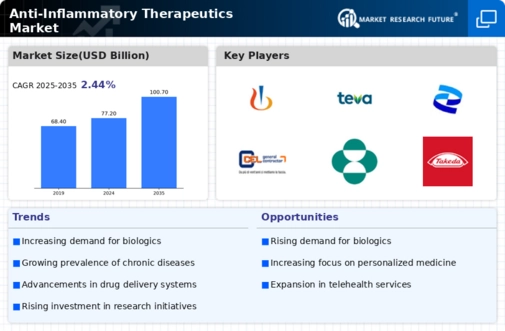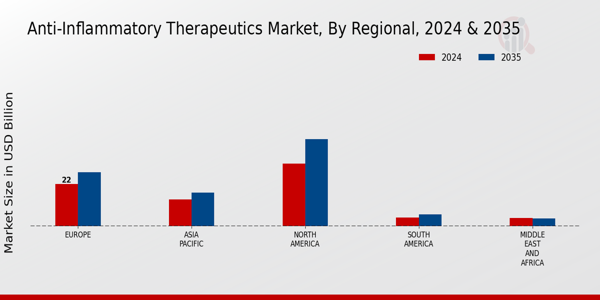Market Growth Projections
The Global Anti-Inflammatory Therapeutics Market Industry is projected to experience substantial growth, with estimates indicating a market size of 77.2 USD Billion in 2024 and 100.7 USD Billion by 2035. This growth trajectory suggests a compound annual growth rate of 2.45% from 2025 to 2035, reflecting the increasing demand for anti-inflammatory treatments. The market's expansion is driven by various factors, including rising prevalence of inflammatory diseases, advancements in drug development, and growing awareness among patients and healthcare providers. These projections highlight the industry's potential and the opportunities that lie ahead.
Growing Awareness and Diagnosis
The Global Anti-Inflammatory Therapeutics Market Industry benefits from heightened awareness and improved diagnostic capabilities for inflammatory diseases. As healthcare providers become more adept at recognizing these conditions, patients are more likely to seek treatment. Public health campaigns and educational initiatives play a crucial role in this awareness, leading to earlier diagnosis and intervention. Consequently, this trend is likely to bolster the demand for anti-inflammatory therapeutics, supporting the market's growth trajectory. The increased focus on patient education and access to healthcare services may further enhance the industry's potential.
Advancements in Drug Development
Innovations in drug development significantly influence the Global Anti-Inflammatory Therapeutics Market Industry. The emergence of biologics and novel small molecules offers new avenues for treatment, enhancing efficacy and reducing side effects. Companies are increasingly investing in research and development to create more effective anti-inflammatory agents. For example, the introduction of monoclonal antibodies has revolutionized treatment protocols for various inflammatory conditions. This focus on advanced therapeutics is expected to contribute to the market's expansion, potentially reaching 100.7 USD Billion by 2035, as new therapies gain regulatory approval and enter the market.
Regulatory Support and Approvals
Regulatory bodies worldwide are increasingly supportive of the Global Anti-Inflammatory Therapeutics Market Industry, facilitating the approval of new therapies. Streamlined processes for clinical trials and expedited review pathways encourage pharmaceutical companies to bring innovative treatments to market. This regulatory environment fosters competition and drives advancements in therapeutic options available to patients. As a result, the industry is likely to witness a steady influx of new products, contributing to its growth. The anticipated compound annual growth rate of 2.45% from 2025 to 2035 underscores the positive impact of regulatory support on market dynamics.
Emerging Markets and Economic Growth
The Global Anti-Inflammatory Therapeutics Market Industry is poised for expansion in emerging markets, where economic growth and increasing healthcare access are evident. Countries in Asia-Pacific and Latin America are experiencing rising disposable incomes, leading to greater investment in healthcare infrastructure. This trend facilitates the availability of anti-inflammatory therapeutics, as more patients gain access to necessary treatments. As these markets develop, the demand for effective anti-inflammatory solutions is expected to rise, further propelling the industry forward. The potential for growth in these regions presents a significant opportunity for stakeholders in the market.
Rising Prevalence of Inflammatory Diseases
The Global Anti-Inflammatory Therapeutics Market Industry experiences a notable surge due to the increasing prevalence of inflammatory diseases such as arthritis, asthma, and inflammatory bowel disease. As populations age and lifestyle factors contribute to these conditions, the demand for effective anti-inflammatory treatments escalates. For instance, arthritis alone affects millions globally, prompting healthcare systems to seek innovative therapeutic solutions. This trend is projected to drive the market's growth, with estimates suggesting that the industry could reach 77.2 USD Billion in 2024, reflecting a growing need for targeted therapies.

























